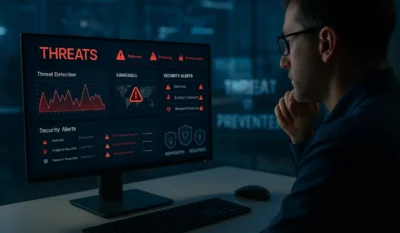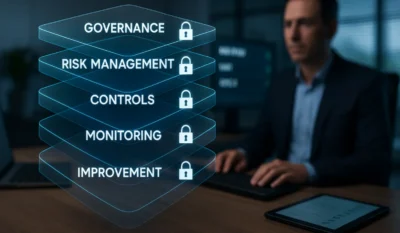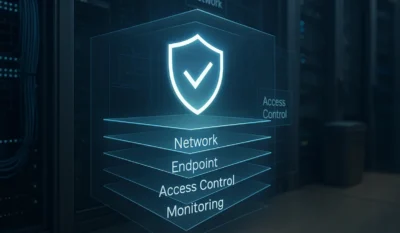Your factory floor doesn’t just run machines; it’s powering critical infrastructure. From SCADA systems and programmable logic controllers to real-time automation and data feedback loops, your ICS environment runs the core systems that keep production moving. But with that control comes an increasing vulnerability.
Threat actors are targeting industrial control system security with increasing precision, and traditional IT defenses simply weren’t built for the complexity of OT networks. According to the SANS Institute, 27% of organizations experienced at least one security incident involving their ICS or OT environments in the past 12 months. This number is a wake-up call.
A single breach in your ICS network can override access controls, shut down key systems, and spark chain-reaction failures across supply chains, safety systems, and even public utilities. With agencies like CISA urgently advising manufacturers to harden their operational environments, it’s clear: mitigating cyber risk in ICS environments is mission-critical.
This guide delivers a manufacturer-specific roadmap to industrial cybersecurity, covering the most urgent threats and proven strategies to defend your OT environment. Along the way, we’ll show you how Keystone equips you to build resilience where it matters most.
Key Takeaways
- Cyber threats targeting industrial control systems are growing; protecting your ICS network is now a critical business priority.
- You must go beyond traditional IT security to defend OT networks and SCADA systems from unauthorized access.
- Segmenting networks, enforcing strong access control, and following NIST-aligned practices are foundational to a secure ICS environment.
- Securing your industrial processes protects uptime, safety, and your company’s reputation.
- Work with a specialized partner like Keystone to implement the industrial cybersecurity solutions your factory needs.
Understanding Industrial Control Systems (ICS) and Their Vulnerabilities
What are ICS and OT?
Industrial control systems (ICS) are the digital nervous system of modern manufacturing, tasked with monitoring, managing, and automating everything from assembly lines and power distribution to water treatment and material handling. These systems include:
- SCADA (Supervisory Control and Data Acquisition): Used for remote monitoring and control across large-scale industrial sites.
- PLCs (Programmable Logic Controllers): Specialized computers that manage automated machinery and equipment on the plant floor.
- DCS (Distributed Control Systems): Systems that handle control functions distributed across the plant.
- RTUs (Remote Terminal Units): Devices that collect sensor data and communicate with SCADA systems.
- HMIs (Human-Machine Interfaces): User interfaces that allow operators to interact with the automation systems.
These systems are what OT environments rely on to keep operations running.
Why ICS Environments Are So Vulnerable to Cyber Risk
Despite their importance, ICS networks were never designed with cybersecurity in mind. That makes them prime targets for today’s threat actors. Here’s why:
- Legacy Architecture: Most ICS components were built decades ago with little or no cybersecurity controls, and patch management is often nonexistent.
- No Room for Downtime: Security patches or system reboots are difficult to schedule without disrupting production, often leaving vulnerabilities unaddressed.
- Opaque Protocols: ICS uses proprietary or outdated communication protocols not well-understood by traditional IT tools.
- Flat Network Design: Many OT networks are not properly segmented, making lateral movement easy once attackers breach the perimeter.
- Unsecured Physical Access: Unlike IT systems stored in secure data centers, ICS components are often accessible on the factory floor.
- Long Lifecycle: ICS systems may remain in use for 15–20 years or more, long after security standards have outpaced them.
The result? an interconnected environment where one weak point can lead to major disruptions.
Threat Landscape for ICS and OT Environments
What Drives ICS Cyber Attacks
Threat actors targeting ICS environments aren’t just after data; they’re after disruption, trade secrets, or physical damage. Key motivations include:
- Ransomware for Profit: Locking down ICS to extort high-dollar payments from manufacturers.
- Corporate Espionage: Stealing intellectual property, such as process control algorithms or product formulations.
- Nation-State Sabotage: Disrupting critical infrastructure to weaken national or regional stability.
- Insider Mistakes or Malice: Human error or rogue employees enabling security breaches from within.
Most Common ICS Attack Vectors
- Unsecured Remote Access: Exposed VPNs, Remote Desktop Protocol (RDP) sessions, and vendor portals remain low-hanging fruit for attackers.
- Phishing & Social Engineering: Initial compromise often starts in the IT layer, then pivots to OT networks.
- Targeted Malware: Threats like Stuxnet, Triton, and Industroyer are designed specifically to sabotage ICS components.
- Vulnerable Supply Chains: Compromised third-party software or hardware can silently introduce threats into your ICS environment.
- Physical Infiltration: Malicious actors exploit direct access to unmanaged endpoints like USB ports or local interfaces.
Fallout from a Successful ICS Breach
The consequences of a compromised ICS are costly and often devastating:
- Production Shutdowns: Entire lines or facilities can grind to a halt for hours, days, or longer.
- Machinery Damage: Misconfigured PLCs or tampered sensors can lead to equipment failure.
- Safety Incidents: Disabled alarms, valves, or overrides can endanger employees and nearby communities.
- Environmental Impact: Chemical spills, water treatment failures, and emissions violations.
- Massive Financial and Reputational Loss: From legal penalties and lost revenue to brand erosion and stakeholder mistrust.
Cyber threats to ICS are now a real risk for every manufacturer. Understanding the risks is the first step toward a hardened defense.
10 Essential ICS Cybersecurity Strategies
1. Network Segmentation Using the Purdue Model
The Purdue Model provides a foundational structure for organizing ICS environments. Segment your OT and IT networks across distinct layers, from enterprise (Level 5) to process control (Level 0), using industrial DMZs, firewalls, and access control lists.
This layered approach isolates critical assets and prevents attackers from moving across your ICS network laterally. Proper segmentation dramatically reduces the blast radius of any cyber intrusion.
2. Robust Identity and Access Management (IAM)
Restricting access is a core tenet of cybersecurity. Apply multi-factor authentication (MFA) to all remote and administrative logins. Enforce the principle of least privilege to ensure users can only access systems necessary for their role.
Review and audit access permissions regularly, especially for ICS operators, engineers, and third-party vendors. These measures prevent unauthorized access and mitigate insider risk.
3. Comprehensive Asset Inventory and Vulnerability Management
A current asset inventory is your foundation for ICS defense. Document all hardware, software, firmware versions, and communication protocols.
Perform vulnerability assessments on a routine basis using OT-aware scanning tools. Where patching is not feasible due to uptime requirements, deploy virtual patching, segmentation, or endpoint hardening as compensating controls.
4. Specialized Cybersecurity Monitoring and Threat Detection
Standard IT tools aren’t built for ICS. Use OT-native security platforms that monitor network traffic quietly, understand the language SCADA systems use to communicate, and spot anything unusual from baseline behavior.
Integrate ICS threat detection into a centralized IT/OT Security Operations Center (SOC) to ensure rapid, contextual response to threats. It looks for unusual behavior that might signal an attack, even if it doesn’t match a known threat pattern.
5. Secure Remote Access
Remote access is often the weakest link. Eliminate direct internet exposure. Use jump servers, secure VPN tunnels, session logging, and MFA to control and monitor access.
Limit remote access to specific time windows or user roles, and continuously audit usage. These steps close off one of the most commonly exploited vectors in ICS breaches.
6. Data Backup and Disaster Recovery for OT
Backups aren’t just for IT systems. Create and test offline, immutable backups of PLC logic, HMI configurations, historian databases, and SCADA parameters.
Securely store backups and design recovery workflows that minimize downtime and align with safety protocols. A robust disaster recovery plan ensures operational continuity in the face of ransomware or system failures.
7. Security Awareness Training for OT Personnel
Cybersecurity isn’t just technical; it’s cultural. Train ICS operators, technicians, and maintenance teams to recognize phishing attempts, report anomalies, and follow secure procedures when using universal serial bus (USB) drives, laptops, or mobile devices.
Role-specific training programs help embed cybersecurity into daily operations and reduce the risk of human error.
8. Incident Response Planning
Develop response plans tailored to ICS-specific scenarios, such as compromised PLCs or unauthorized control system changes. Plans should include coordination with safety protocols, isolation procedures, and forensic readiness.
Conduct tabletop exercises and red team assessments to test readiness and refine playbooks.
9. Secure Supply Chain Management
ICS components often originate from multiple suppliers and original equipment manufacturers (OEMs). Conduct due diligence on all vendors, require cybersecurity certifications or attestations, and continuously monitor third-party risk.
Implement controls that detect tampered firmware or unauthorized changes to supply chain software. This mitigates the growing threat of supply chain attacks.
10. Zero Trust Architecture for OT
Zero Trust for ICS doesn’t mean adding friction; it means adding precision. Continuously authenticate all users and devices, enforce granular access controls at the protocol level, and break the system into smaller zones so that access is tightly controlled between each part.
Even trusted internal devices must prove legitimacy on every transaction. This approach reduces the amount of time an attacker can stay hidden in your system after getting in.
Challenges of Implementing ICS Cybersecurity
Implementing robust ICS cybersecurity faces multiple challenges:
- Operational Constraints: ICS requires constant uptime, limiting maintenance windows.
- Skill Shortages: There is a significant skills gap in professionals proficient in both IT and OT cybersecurity.
- Integration with Legacy Systems: Modern security practices can be difficult to apply to legacy ICS.
- Visibility Issues: Gaining visibility without disrupting operations is challenging.
- IT/OT Cultural Divide: Bridging the gap between IT and OT teams can hinder collaboration.
- Budget Constraints: Justifying cybersecurity investments can be complex.
Addressing these challenges effectively typically requires external expertise from specialized providers who deeply understand both the IT and OT realms.
Keystone: Your Trusted Partner for ICS Cybersecurity
Protecting your industrial control systems requires specialized expertise that standard IT providers cannot offer. Keystone uniquely combines deep IT and OT knowledge to protect your manufacturing operations. Our comprehensive approach includes:
- Risk assessments tailored to OT systems
- Network segmentation based on the Purdue Model
- Industrial-specific cybersecurity monitoring
- Secure remote access solutions
- Detailed OT-specific incident response planning
- Managed security services for continuous protection
We serve as your strategic ally, committed to securing your operations, enhancing safety, and ensuring operational continuity.
Conclusion
If your operations depend on safe, stable systems, ICS cybersecurity must be a priority. Without a hardened security posture, your critical infrastructure is exposed to unauthorized access, unmitigated vulnerabilities, and cascading failures that no business can afford.
As the threat landscape escalates and compliance expectations, such as NIST guidelines, tighten, organizations must evolve beyond generic IT security. This is about purpose-built security solutions for ICS networks and OT environments that demand precision, resilience, and real-world expertise.
Your ICS isn’t just another asset; it’s the engine of your business. Don’t wait for a cyber incident to force action. Build resilience now.
Talk to our team at Keystone to see how we can help protect your ICS systems before threats become outages.




